how to cook live crab
This is a visual tutorial explaining how to clean and cut a whole crab. I'm using a mud crab but the same process applies to any large crabs. This accompanies the Singapore Chilli Crab I published today, arguably one of the BEST crab recipes in the world!
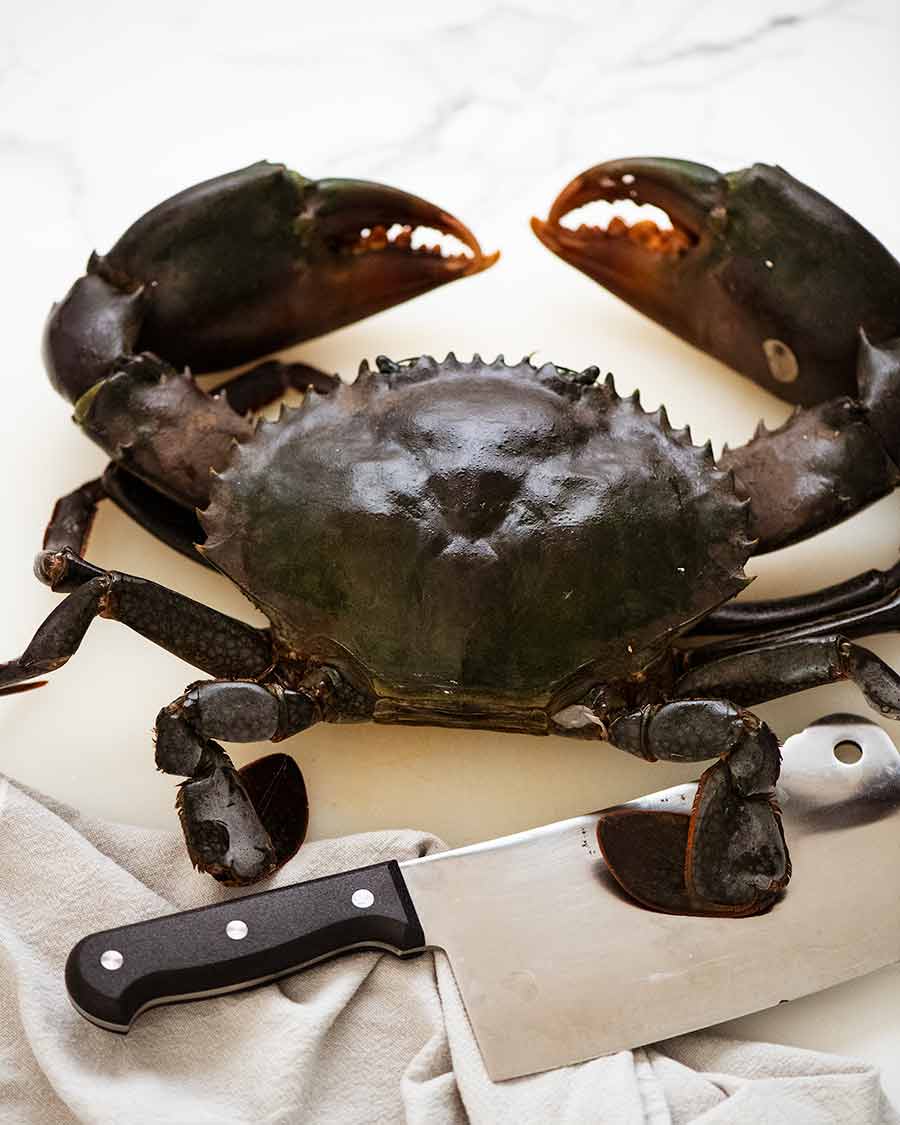
-
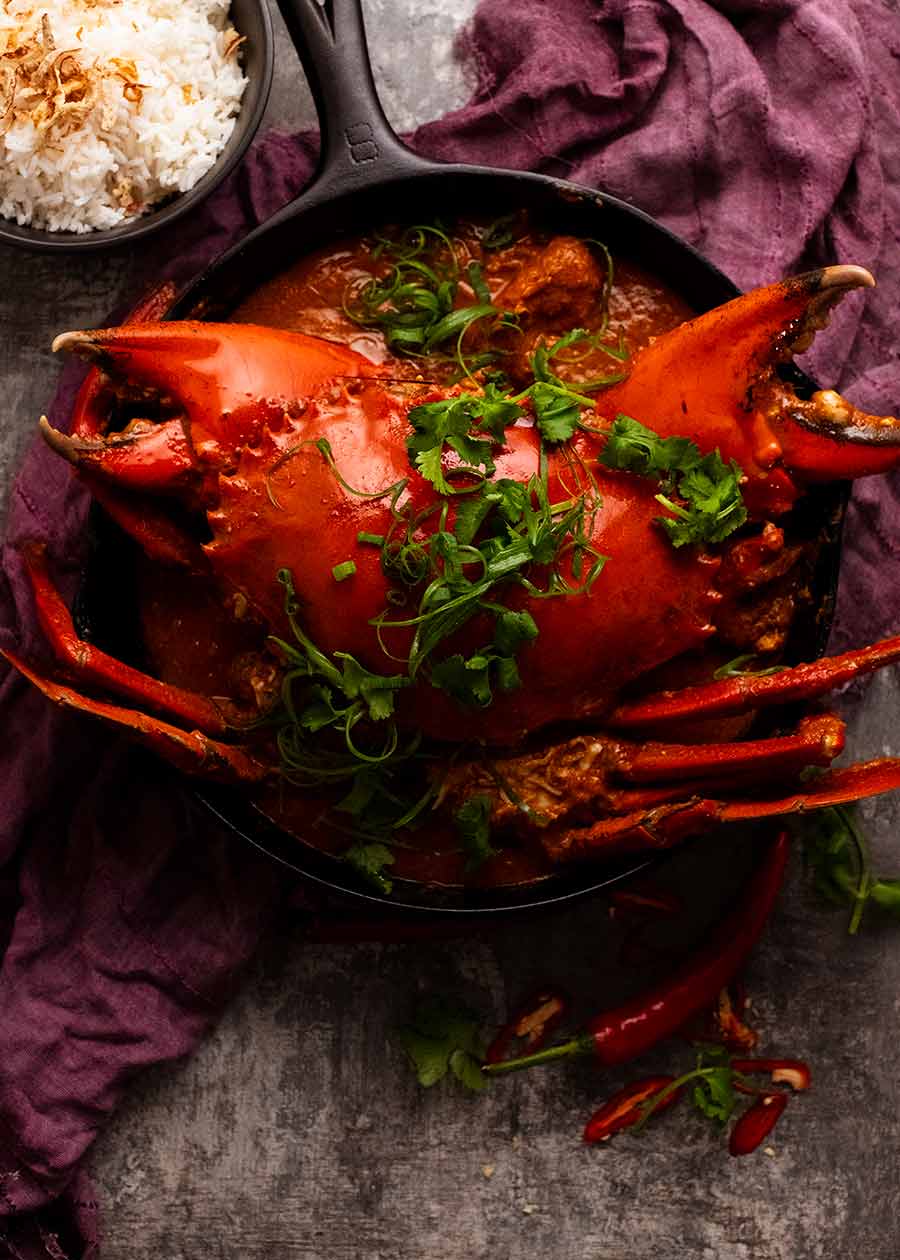
Singapore Chilli Crab -
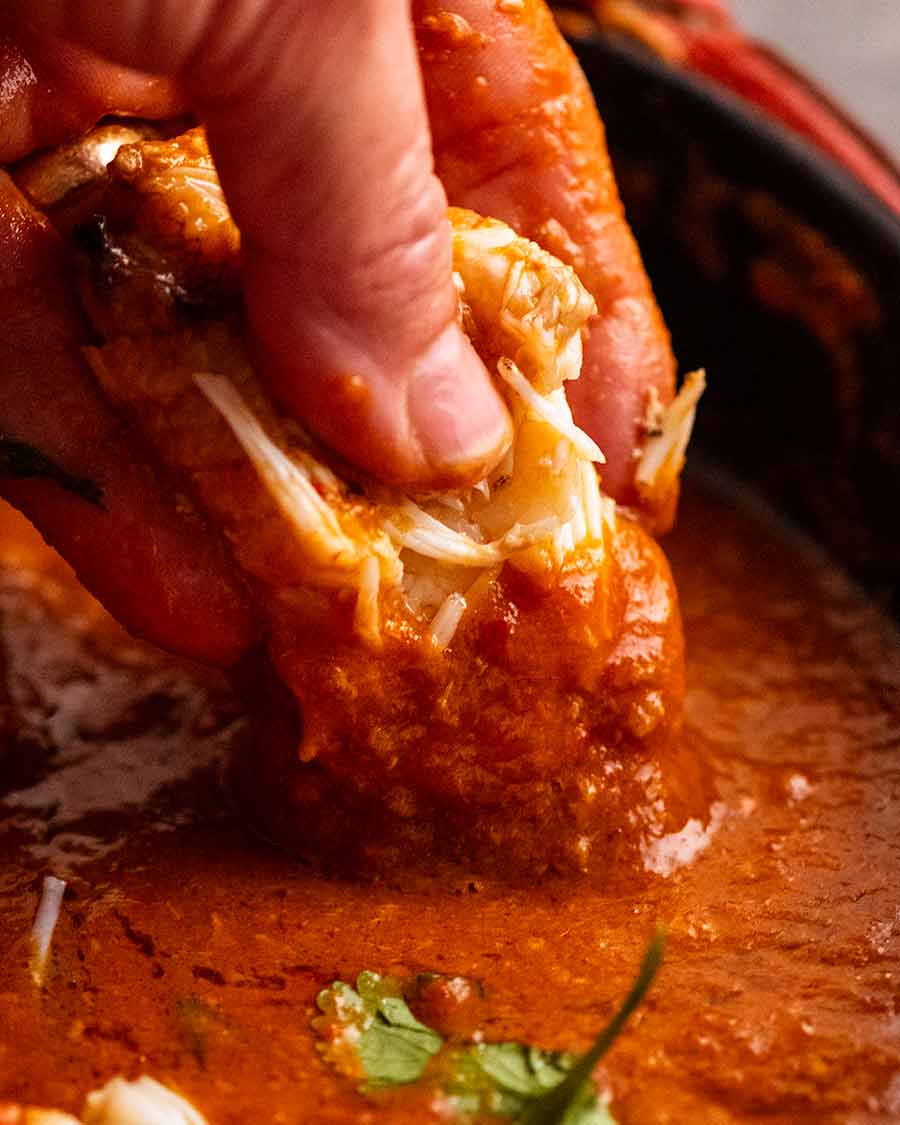
Mud Crab claw being dipped into Singapore Chilli Crab sauce
How to clean and prepare a whole crab
A whole crab – especially a live one – is not the sort of thing I cook with every day! So if your reaction to a crab is something like mine below, you're in the right place. I'm going to walk you through step by step how to clean and prepare a whole crab, then show you how to make one of the most iconic crab dishes in the world, Singapore Chilli Crab!
It's easier than you think. Trust me, you've got this!
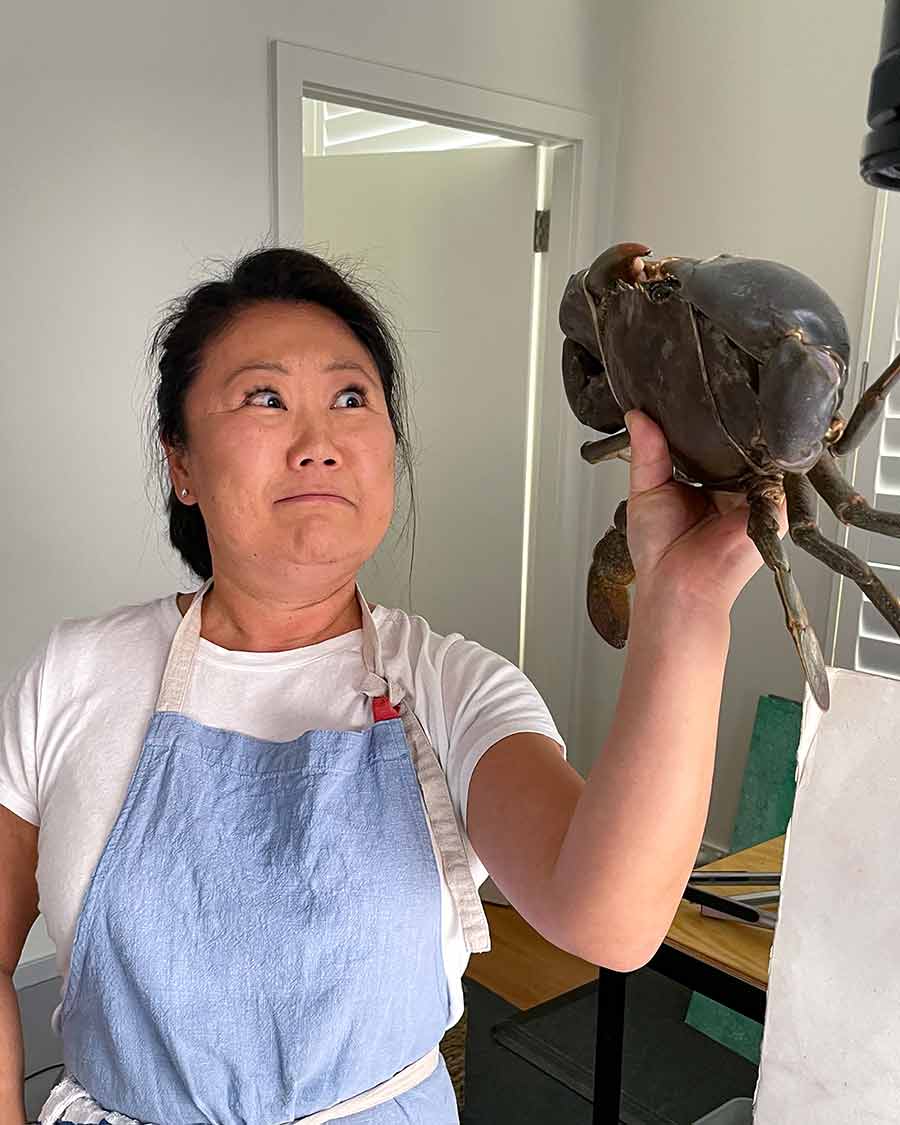
After cleaning and cutting a crab
Once the crab is cut up, you will end up with:
-
Crab pieces; and
-
Crab juice plustomalleywhich is also affectionately known as "crab mustard". It's actually the liver and pancreas of the crab, and this stuff is crab gold! It is packed full of crab flavour and, no self respecting foodie would ever create a crab recipe that doesn't make use of it. It's a secret ingredient in Singapore Chilli Crab that gives the sauce a massive savoury boost!
-
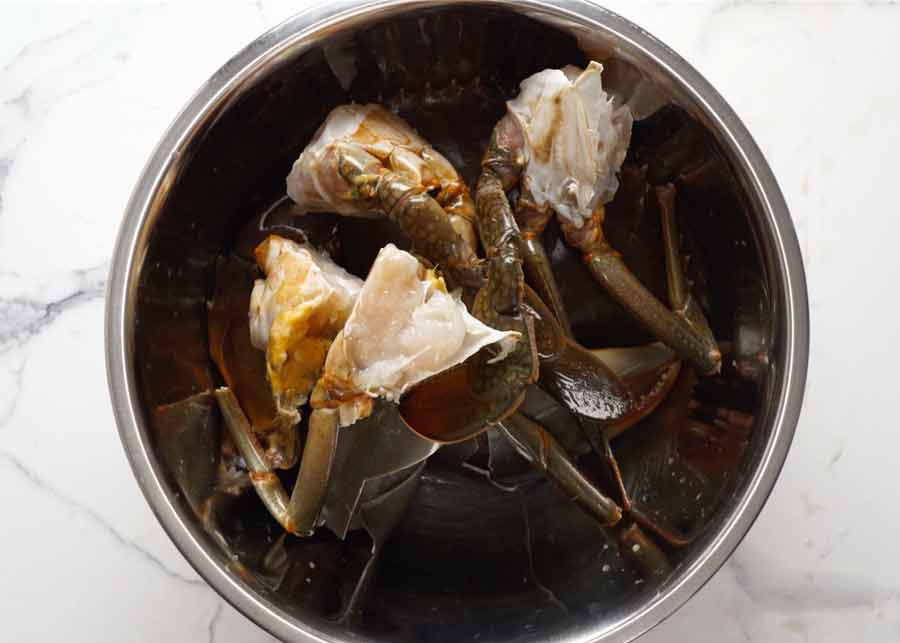
Crab pieces -
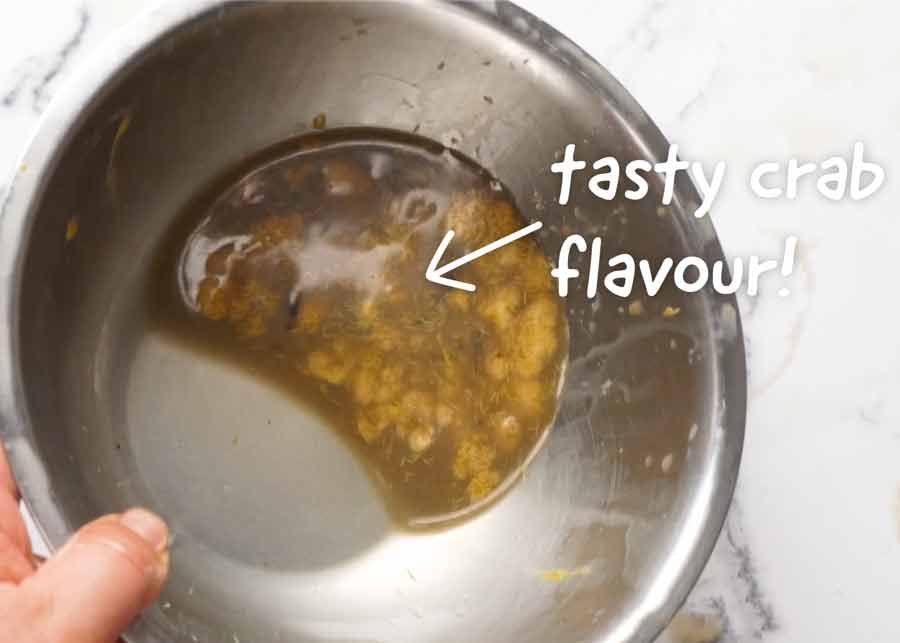
Reserved crab tomalley "crab mustard"
1. Buying and storing a live crab
1.1 Buying a crab
Nothing beats the fresh, sweet juiciness of a live crab! Here in Sydney, live crabs can be bought at the Sydney Fish Markets and some of the better, larger seafood shops.
The claws of large live crabs are strong and dangerous, so crabs will always come with their claws tied. Even so, always hold it from behind or by the top shell to keep your fingers clear of those nippers. If you're still nervous about handling them while alive – and I don't blame you – use sturdy tongs!
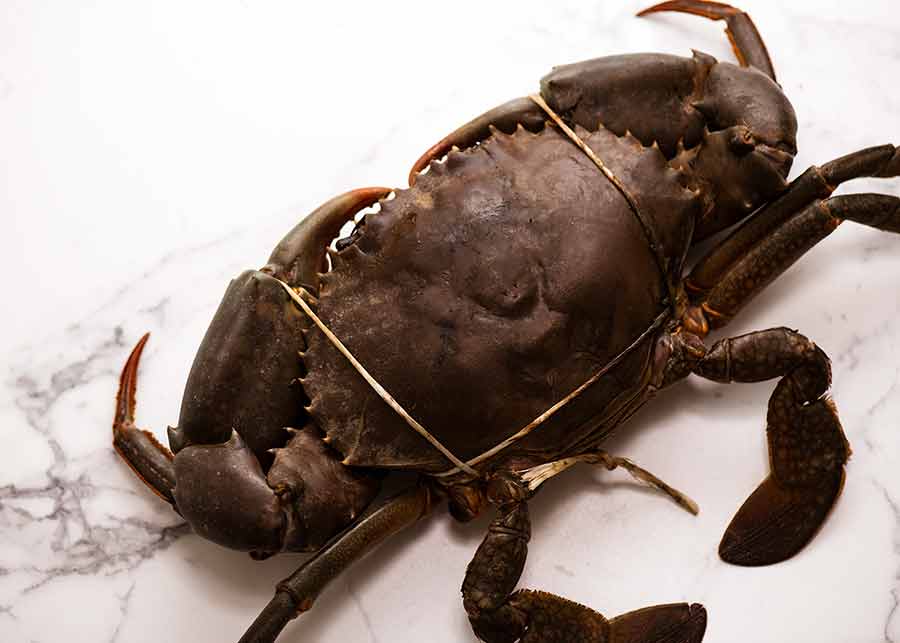
1.2 Storing a crab
For the juiciest, freshest and most flavourful crab, keep it alive until just before cooking.
If you're cooking the crab the same day, simply leave it in a box or bucket in the open air. If you need to store it overnight, place the live crab in the fridge. The coolness of the fridge will subdue the crab, keeping it alive but in a physically depressed state.
Freezing and then thawing a live crab isn't recommended – it defeats the whole purpose of a live crab! There's also a noticeable loss of flavour and juice.
2. Dispatching a live crab
Dispatching a live crab is an unfortunate but necessary business. Doing it in a humane way will ensure the creature does not suffer.
2.1 How to humanely kill a crab
There are a couple of ways to humanely kill a crab for consumption:
-
Spiking – This involves stabbing a knife or other sharp object into the brain and nerve centres of the crab. There's one near the eyes and another near the tail. When done correctly, this kills the crab immediately.
-
Freezing – The cold of a freezer puts the crab in a physically depressed, coma-like state so it feels nothing when you butcher it. This is the method I use, covered below.
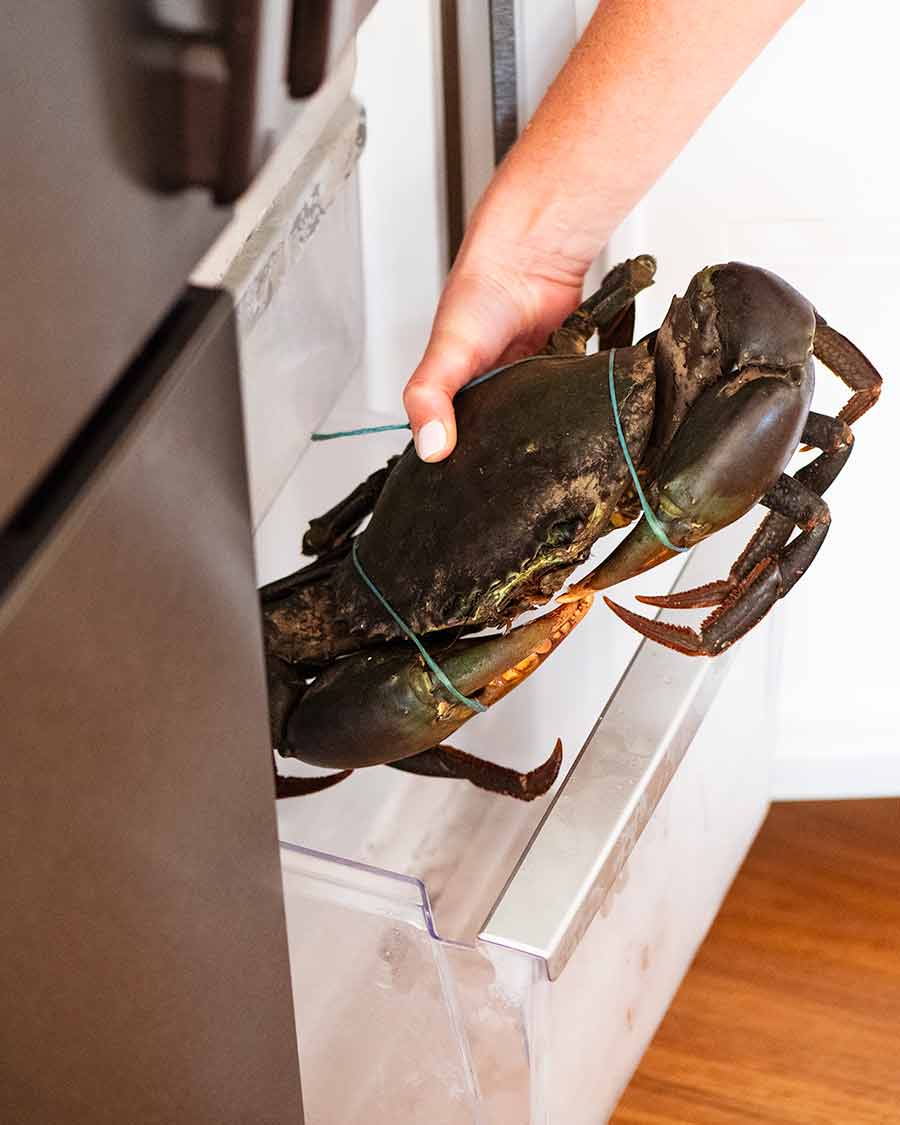
2.2 How to dispatch a crab by freezing it
Place the live crab in the freezer until it completely stops moving but before the crab starts to freeze. This takes about 1 hour for a 1.5kg / 3lb crab. Don't leave it longer or it will eventually freeze and die, which degrades the flesh and defeats the purpose of buying live crab!
Ensure that the eyes and limbs are no longer moving, it's not bubbling around the mouth (breathing) and the legs hang limp.
At this stage, the crab will still be alive but is in a numbed, coma-like state of torpor. It is physically inactive and no longer feels any sensation. This occurs in crabs at temperatures of 4°C / 39°F or lower. Once it's in this state, start preparing the crab immediately.
Watch how to do this step
3. How to clean and prepare crab
In this section, I'm sharing how to break down a crab for use in Singapore Chilli Crab. However, crab pieces prepared this way are suitable for use in any dish where crab is served in pieces in the shell.
3.1 Preparation and equipment
You will need:
-
A large cutting board
-
Kitchen scissors
-
A Chinese butcher's knife, cleaver or very heavy duty kitchen knife
-
Three bowls – for edible crab pieces, reserving crab "mustard", and a rubbish bowl
-
Wet cloths and tea towels
3.2 Remove sharp tips of legs
Place the crab you put to sleep in the freezer on the cutting board. Use scissors to cut off the sharp tip off each leg and discard. It's best to get this out of the way first so you don't poke yourself with them when handling the crab!
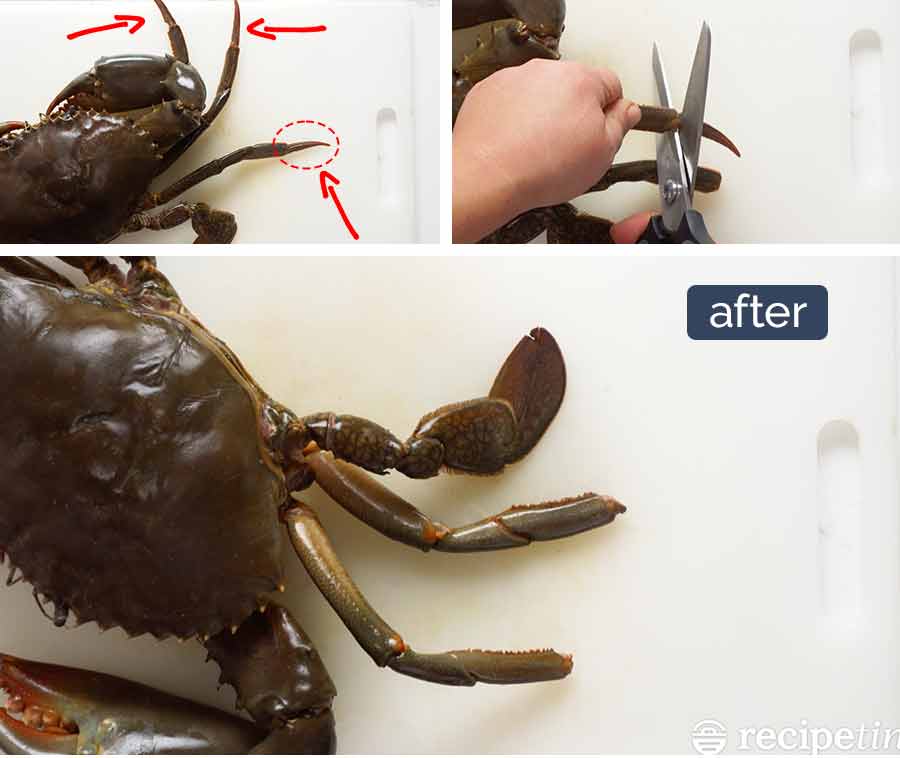
Watch how to do this step
3.3 Remove belly flap
Next, turn the crab over and remove the flap on the underside of the crab so we can remove the top shell. Lift up the flap and twist it off (discard).
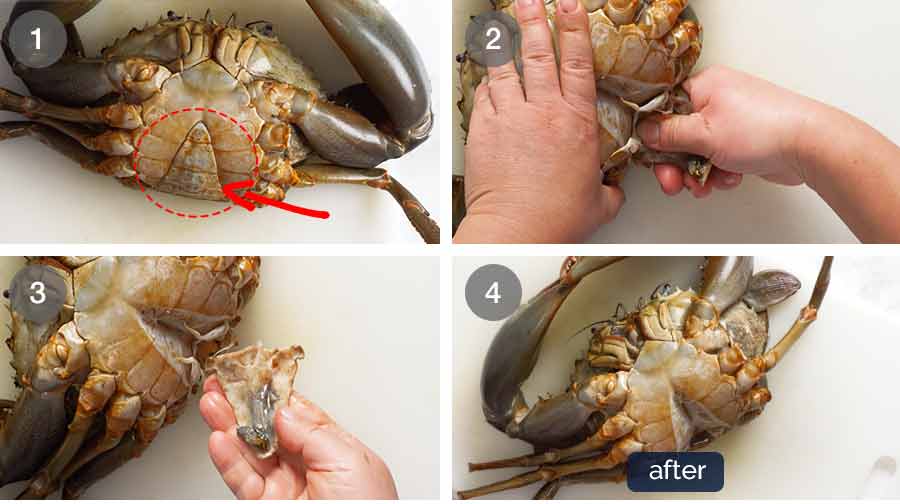
Watch how to do this step
3.4 Remove top shell (carapace)
Next remove the top shell, called the carapace. Do this from the back of the crab, as indicated by the arrow in step 1 below. Stick your thumb under the shell, pull it up and off.
It's usually easy but on occasion it just won't budge! In this case, run a small knife down each side of the top shell then remove the top shell.
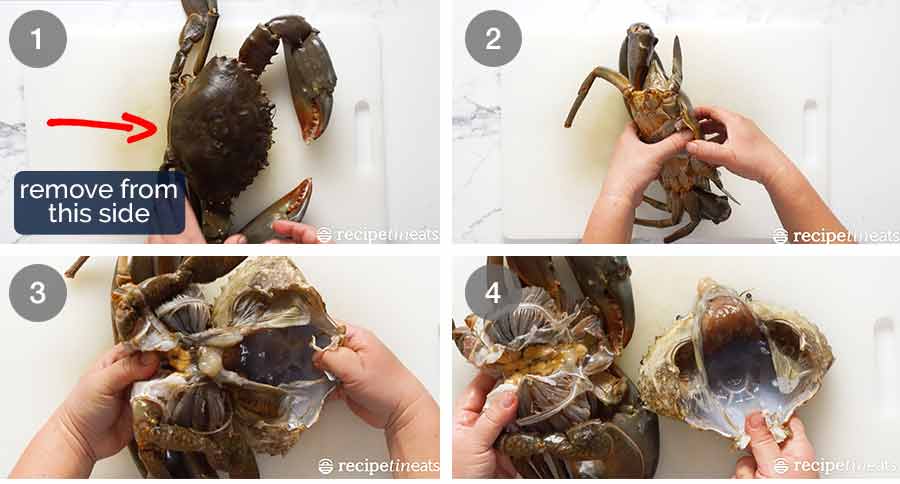
Watch how to do this step
3.5 Reserve tomalley (crab "mustard") from top shell
Inside the top shell you will see a funky-looking grey membrane and a yellow-green (or brown) substance. The grey stuff is of no interest to us, but the yellow stuff is gold! It's called tomalley and it's actually the crab's liver and pancreas. Affectionately known as crab "mustard" or "crab fat", it's packed with intense crab flavour and is not to be wasted! It is a key ingredient in the magic sauce for Singapore Chilli Crab.
To reserve the tomalley, scrape everything inside the top shell into a new bowl (let's call this the Tomalley Bowl, we'll add more to it later). Later we'll sift through and sort out the good stuff (the tomalley) from the dud stuff (the grey and white stuff which is inedible membrane, guts etc).
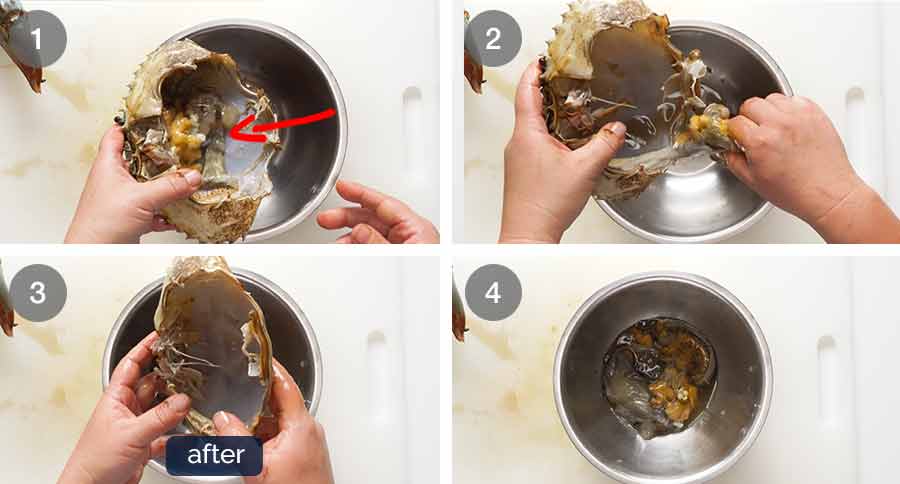
Reserve the now-empty top shell. We're going to use it for decorative purposes in the finished Singapore Chilli Crab dish. Put this in a big bowl into which we will put all the crab meat pieces. Let's call this the Crab Bowl!
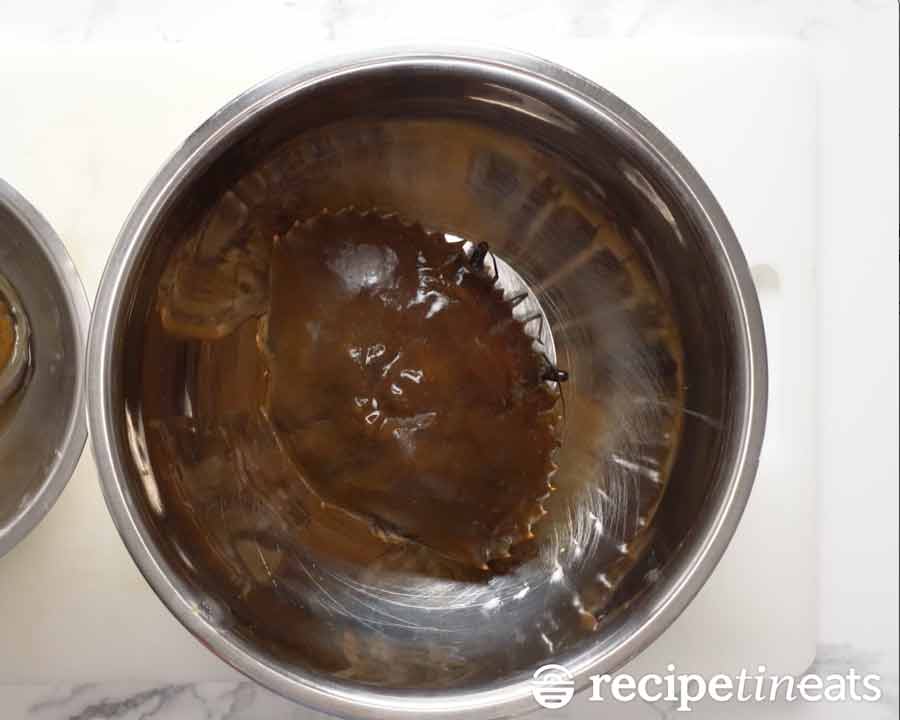
Watch how to do this step
3.6 Reserve tomalley from crab body
Now we turn our attention to the crab body. First we'll reserve the tomalley found here too. Use your fingers (or a teaspoon if you're squeamish) to pull out all the tomalley and any attached grey tissue from the inside of the crab's body. Add it all into the Tomalley Bowl.

As with the top shell, there's no need to be meticulous here. You can see above in step 2 that there is some tomalley stuck on the body cavity, and that's fine. It's going to make that body piece even tastier!
Watch how to do this step
3.7 Remove mandibles
Next, remove the mandibles, part of the crab's mouth that's marked in the photo below. Simple grab each one and twist them off. Discard.
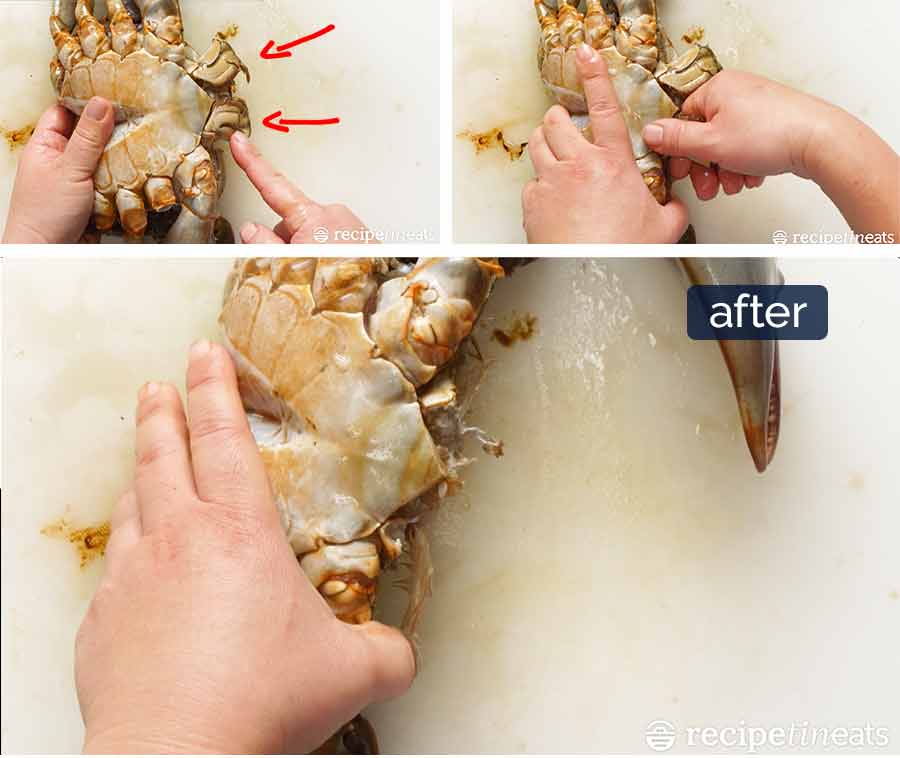
Watch how to do this step
3.8 Remove gills
The gills are inside the body and easily identified thanks to their other name, "dead man's fingers". They are not edible so need to be removed. They come off easily, just tear them off with your hands.
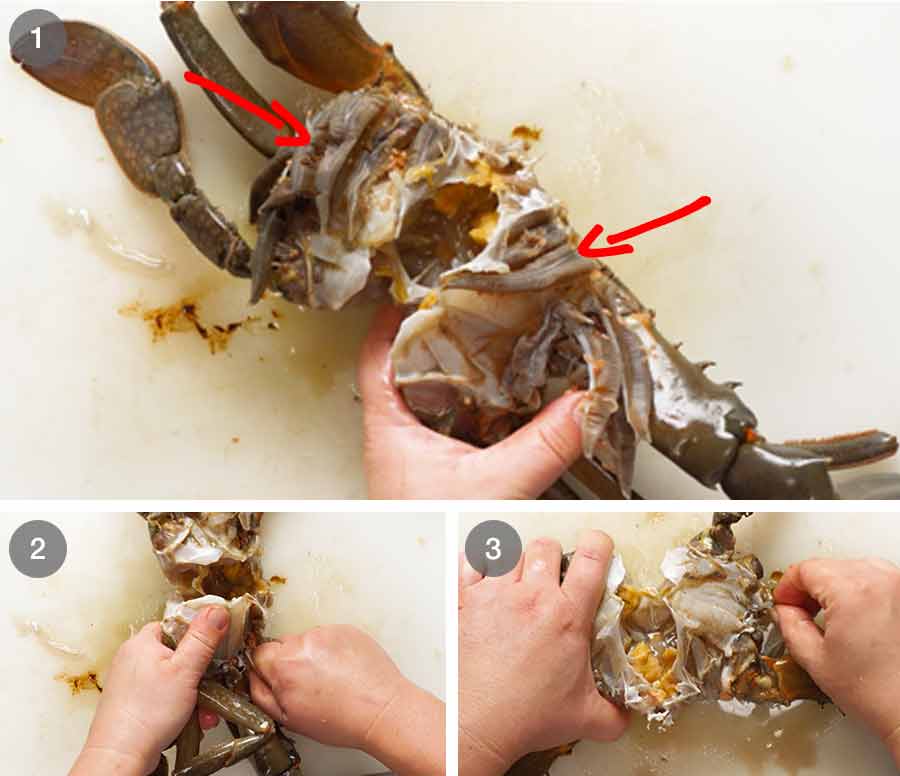
Watch how to do this step
3.9 Cut off crab claws
This is the step that calls for a cleaver or heavy duty knife! Hack the crab's arms off at the point where the arms meet the body. Bring the cleaver down on that point in one motion (watch your fingers!), letting the weight of the cleaver do the work.
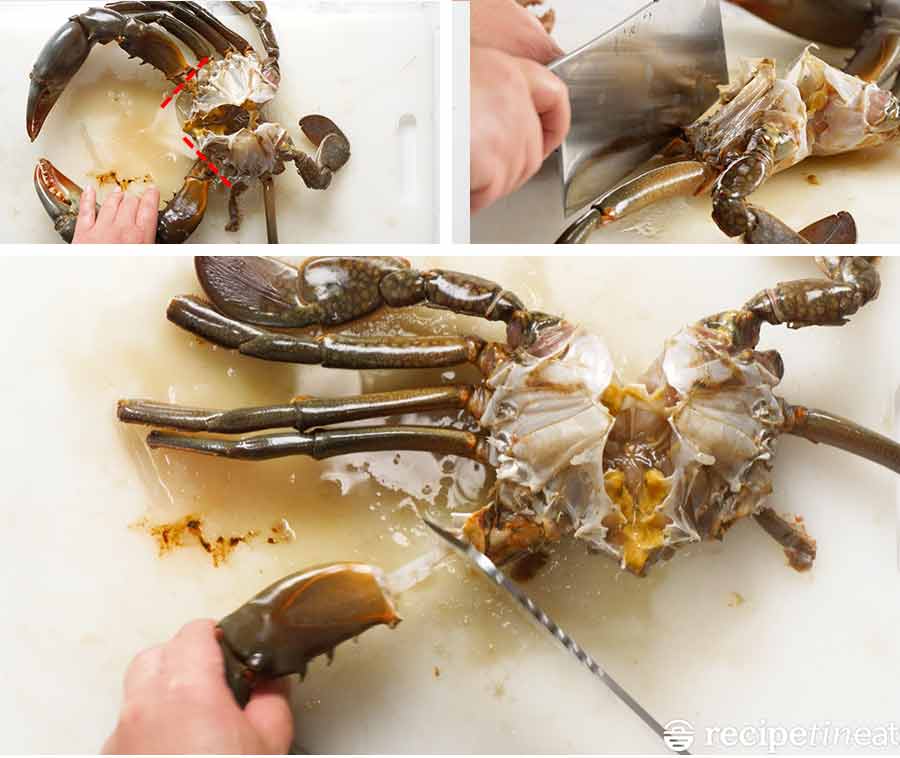
Watch how to do this step
3.10 Crack claws
Now we're going to partially crack the shell of the claws. This serves 2 purposes: firstly to let some heat in so the claw cooks more evenly. And secondly to make the crab meat easier to remove. Be careful not to crack the claw fully open, otherwise the meat might fall out when cooking and break up in the dish.
To crack the shell of the crab claws, use a solid, general-purpose kitchen knife (like a chef's knife). Lay the claw flat, and using the back of the knife (not the blade), smack the middle of the claw firmly until it cracks. Make one crack on each side of the claw.
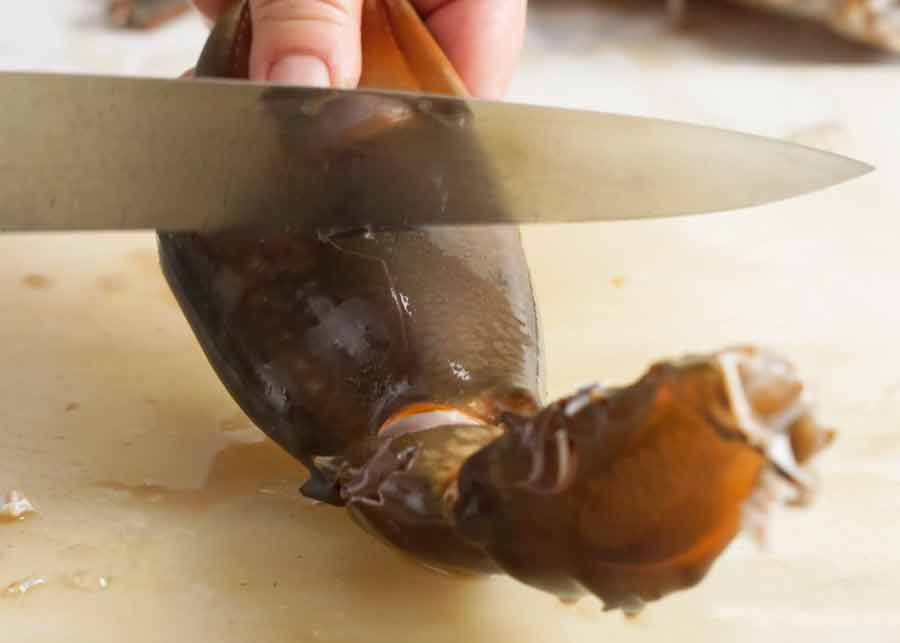
Now using the cleaver again, cut each claw off at the joint. Add the claws and arm pieces to the Crab Bowl.

Watch how to do this step
3.11 Cut crab body into pieces
The crab body should be cut into 4 or 6 pieces, depending on how large the crab is. For a large crab around 1.75kg / 3.5lb, I would cut the body into 6 pieces (two halves, each cut into three). For a smaller 1.25kg / 2.5lb crab, cut the body into 4 pieces.
Using the cleaver, cut the body in half down the middle (step 2 below). Stand one half on its side and cut down through it, so you have two pieces each with legs attached. Repeat with the other half. (Cutting the body up is easy as the shell is quite soft.) Add the crab pieces to the Crab Bowl.
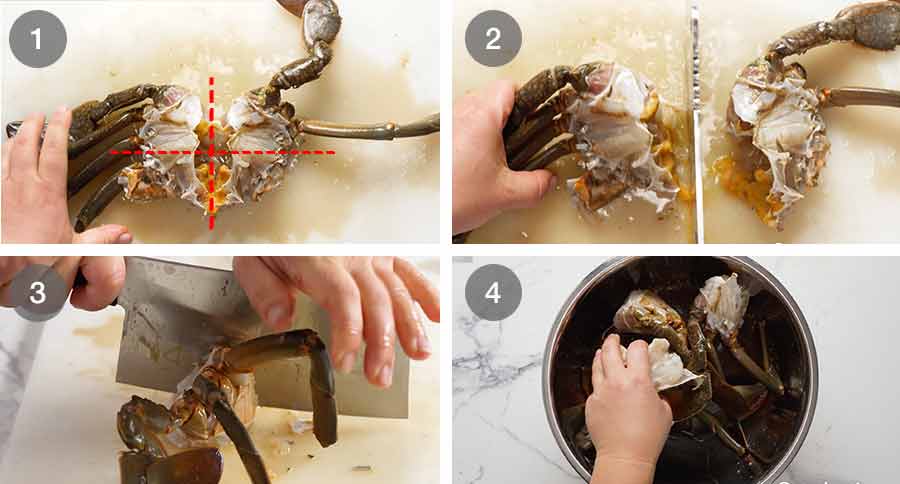
Watch how to do this step
3.12 Crab pieces, done!
And with that, you've got your beautiful crab pieces! Before you start cooking though, we need to deal with the tomalley. No self-respecting foodie would ever create a crab recipe that didn't make use of the tomalley. It's a built-in booster of free crab flavour!
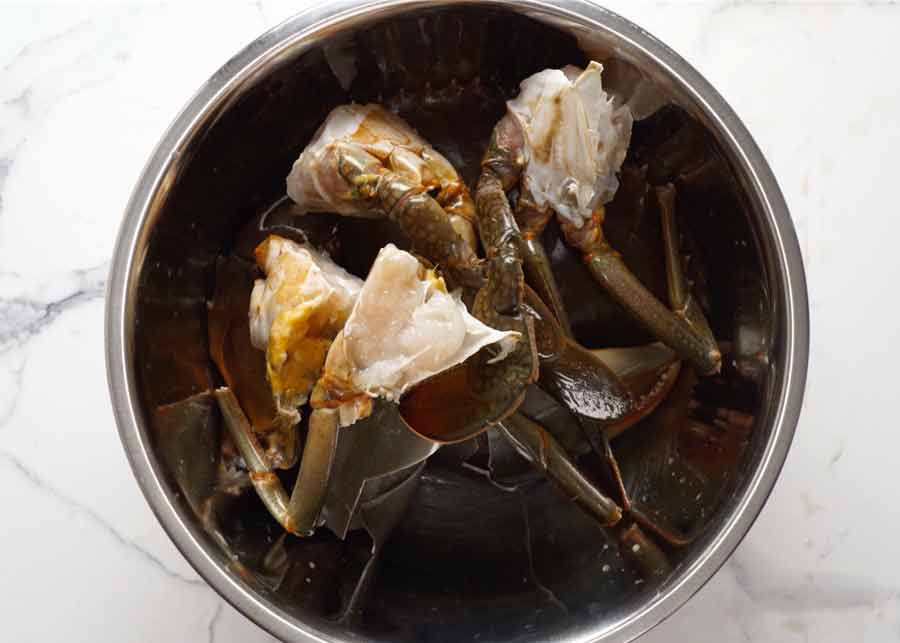
Watch how to do this step
3.13 Cleaning the crab tomalley (crab "mustard")
Scrape all the crab juices that have collected on the cutting board into the Tomalley Bowl – more free crab flavour!

Pick up a piece of membrane (the grey or white lining-like bits) and use your fingers to scrape the yellow and green "paste" off back into the bowl. (OK fine, slime is a better description!)

Discard the membrane. Continue until you've picked out all the membrane and you're left with the yellow and green crab "mustard" in crab juice.
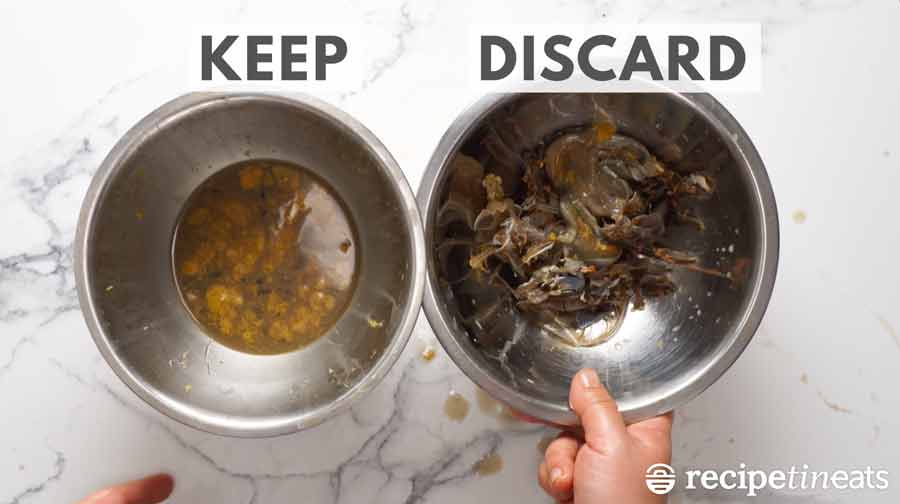
This bowl of completely unappetising-looking goo is worth its weight in flavour gold. Think of it as liquid crab concentrate, supercharging with crab flavour anything it's added to, like the sauce of Singapore Chilli Crab (the recipe today's crab is for).

Watch how to do this step
3.14 Cooking the crab
Tomalley ready to go, crab pieces prepared … congratulations! You just successfully broke down a whole crab! Give yourself a pat on the back. Pour yourself a wine and have a well-earned break. While you sip, let your mind wander to the delicious things this crab is about to be transformed into.
Because now it's time to cook this beauty!! (Like the Singapore Chilli Crab recipe, right here 😇) – Nagi x
Watch how to make it
Subscribe to my newsletter and follow along on Facebook, Pinterest and Instagram for all of the latest updates.
This is a tutorial explaining how to clean and cut a whole live crab, including the humane way to dispatch it. Tutorial videos with detailed step photos and diagrams are in the post above. The directions written below are concise and abbreviated, so read the post first.
And what to make with the crab once you've prepared it? Try this Singapore Chilli Crab!!
Tip: For best results, keep the crab alive for as long as you can before cooking it. This will yield the most succulent, flavourful crab of your life!
- 1 kg+ / 2lb+ whole mud crab or other crab(s) , preferably live (Note 1)
Dispatch the crab (Note 2):
-
Freeze 1 hour: Place the crab in the freezer for 1 hour or until it stops moving, but don't let the crab freeze. It may take slightly longer for larger crabs. Ensure eyes and limbs aren't moving, no active bubbling around the mouth and legs hang limp.
-
Once the crab is asleep, prepare it straight away. (Note 3)
Cleaning and cutting crab:
-
Details in post: See diagrams in post for crab body parts referred to in this section.
-
Cut off leg tips: Cut off the sharp tips of each of the legs (not claw).
-
Remove belly flap: Twist off the belly flap and discard.
-
Remove top shell (carapace): Working from the back of the crab, put your thumb between the body and the top shell (carapace) and pull it off. If you have trouble here, run a small knife down each side of the shell first.
-
Reserve tomalley: Scrape out and save the tomalley (yellow and green "crab mustard", Note 4) from top shell and body.
-
Discard mandibles and gills: Remove mandibles and gills, discard.
-
Remove claws: Seperate arms from body using a cleaver.
-
Crack claw shell: Give it a whack with the back of a knife to create some cracks in the shell, but try not to break the shell completely (so the claw still holds together). This helps with even cooking makes it easier to eat. If claws are really large, cut claws from arms at the joint.
-
Cut body up: Cut crab body in half down the middle. Then cut each piece into 2 (or 3 if large).
-
Refrigerate: Place crab pieces in a large bowl and refrigerate until use. Use within 24 hours.
-
Clean tomalley: Scrape all the crab juices from the cutting board into the bowl with the tomalley. Pick out the grey or white membranes and gently scrape off the tomalley (the yellow/green substance) as best you can back into the bowl. Discard all the grey membranes. Keep the crab juices and tomalley for use in cooking – this packs a ton of crab flavour!
-
Use crab pieces as directed by your chosen recipe. Best crab recipe in the world? Singapore Chilli Crab!
1. Crab types – I'm using mud crab here, this crab breakdown process will work for any large crab that needs to be cut into smaller pieces for cooking and eating. Examples:
Australia – Mud crab, blue swimmer crab, spanner crab
US – Dungeness crab, rock crab, stone crab (similar shape to mud crab)
UK – Brown crab (aka edible crab), spider crab
2. Dispatching crab – Crabs should be killed humanely for consumption. Freezing is an easy method of putting the crab in a coma-like state, so it feels no sensation and ceases to move, for butchering. See in post for more details.
3. Cut straight away after removing from the freezer, while the crab is in this physically depressed state. It is still alive but asleep, unable to feel any sensation or move. Live crab freshly cooked = optimum eating experience!
4. Tomalley – This is the crab liver and pancreas, also referred to as "crab mustard" or "crab fat". This is packed full of crab flavour and should be reserved for use in cooking.
Keywords: clean and cut crab, crab recipe, mud crab, whole crab
Life of Dozer
Dozer's reaction to a live mud crab vs mine. 😂
But I couldn't let Dozer show me up! So I gave the giant wriggly mud crab a kiss! 😂
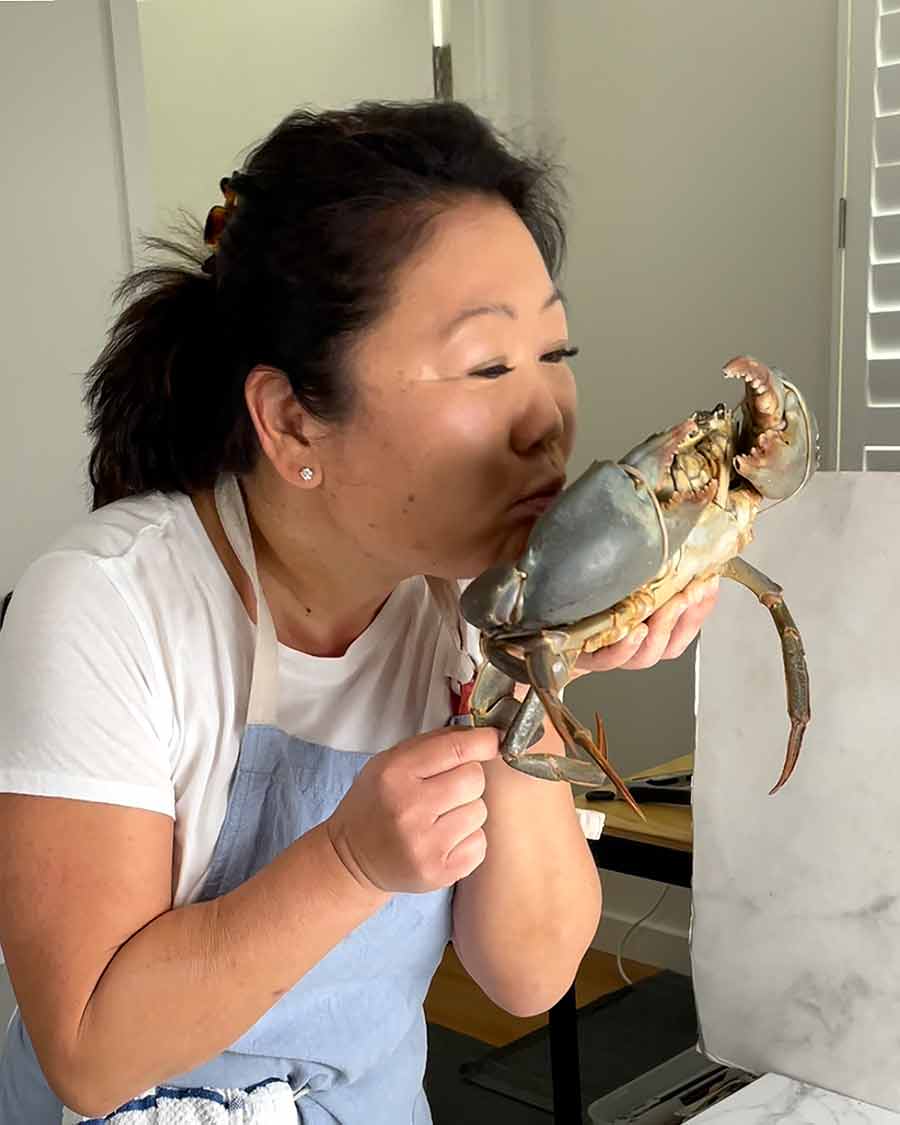
how to cook live crab
Source: https://www.recipetineats.com/how-to-clean-and-cut-a-whole-crab/
Posted by: messerguill1987.blogspot.com

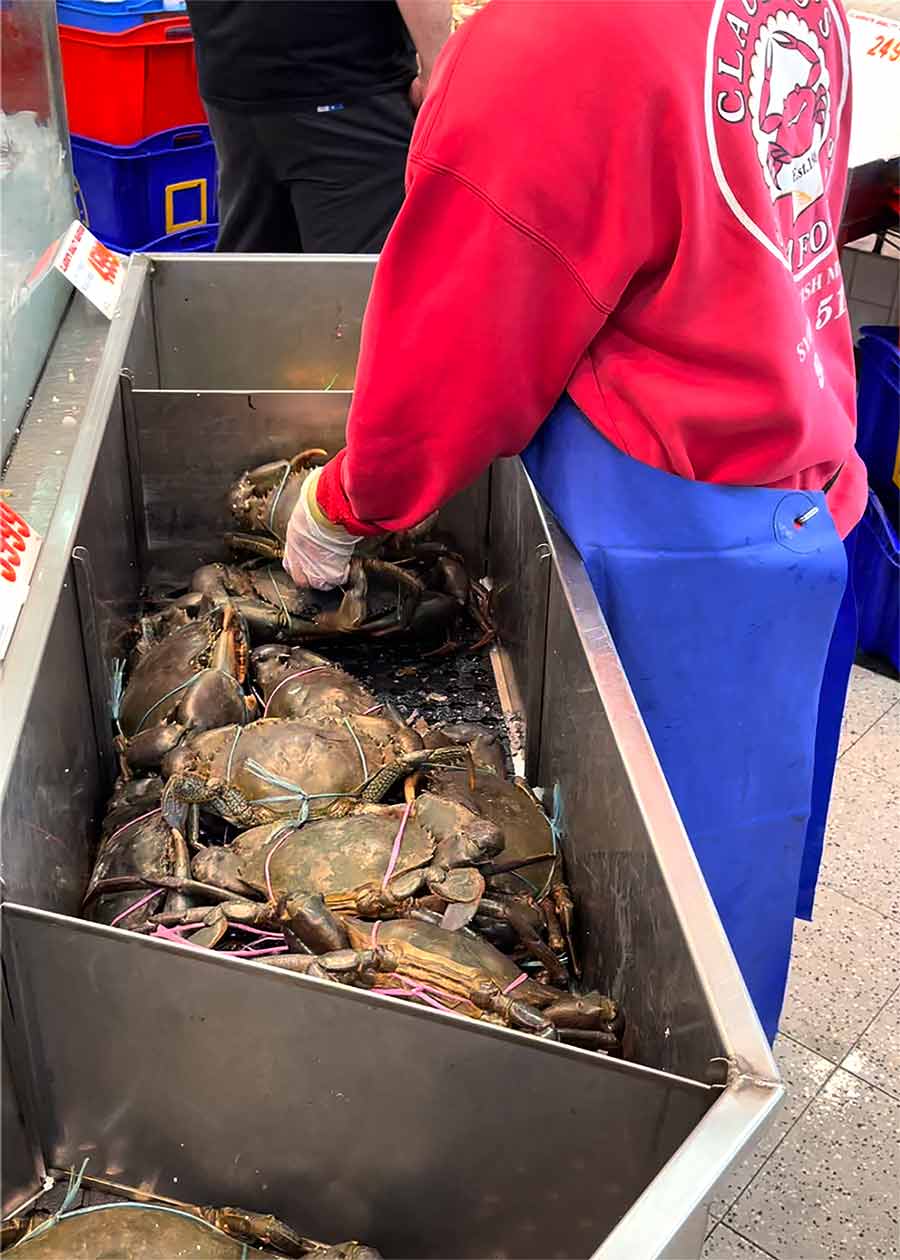

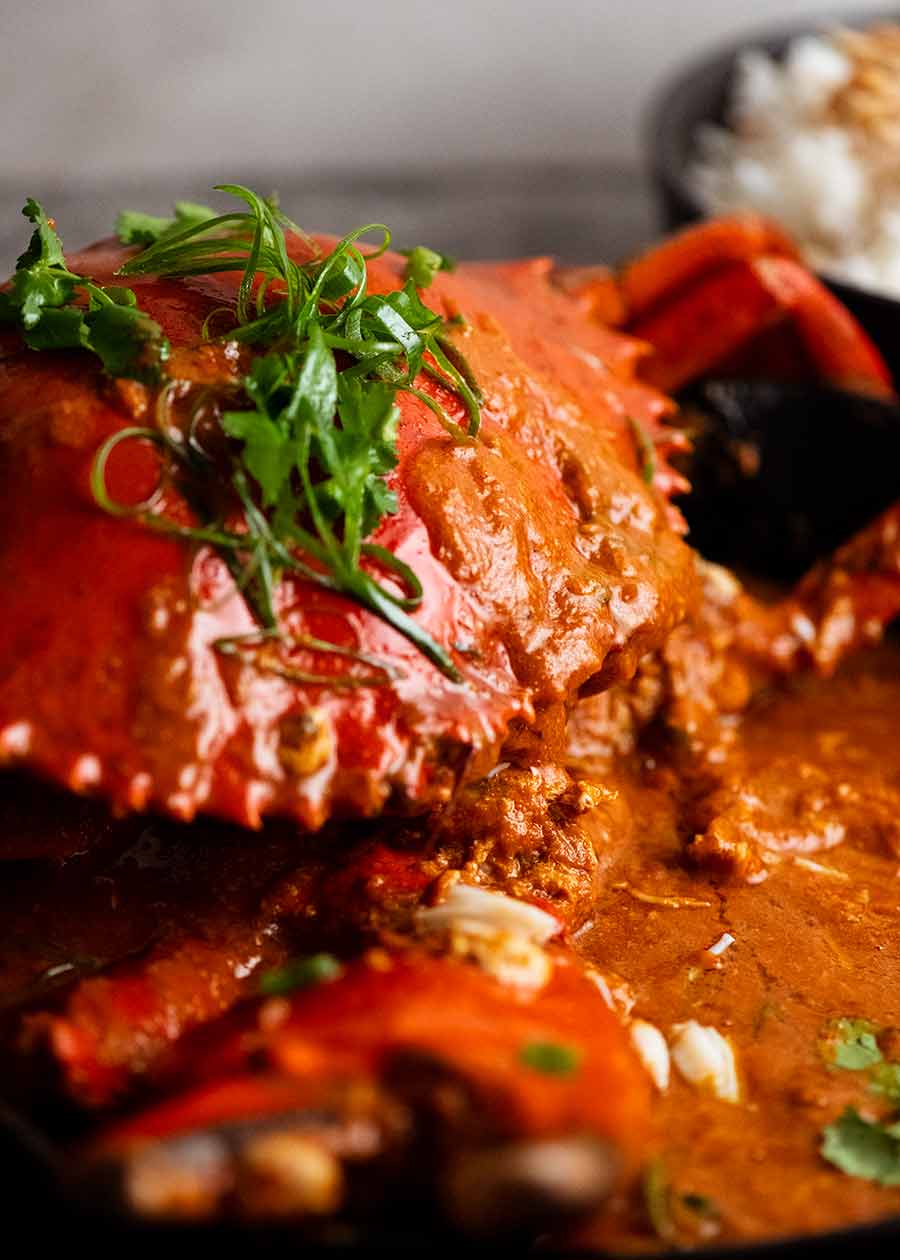
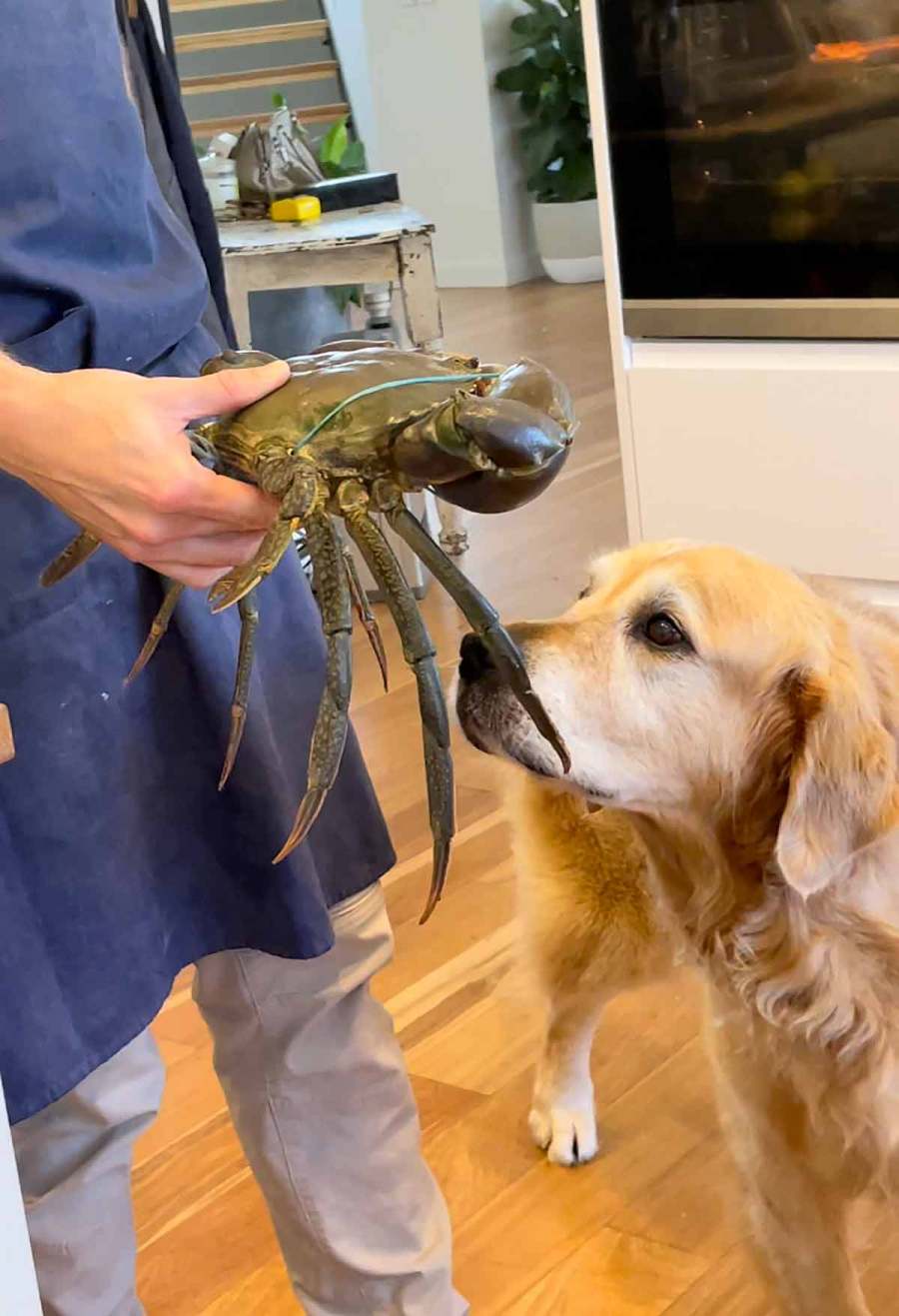
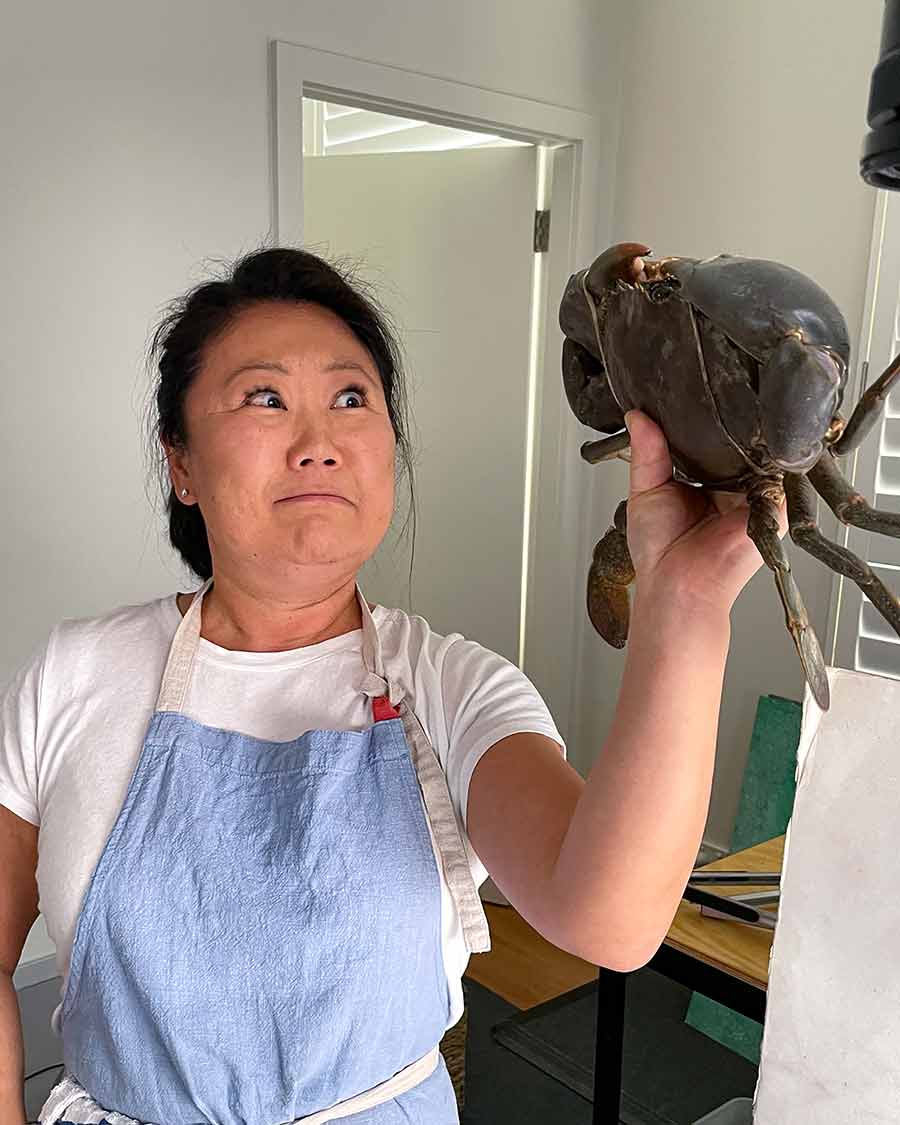
0 Response to "how to cook live crab"
Post a Comment